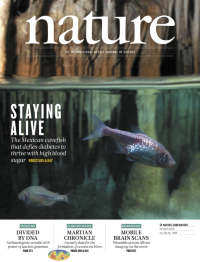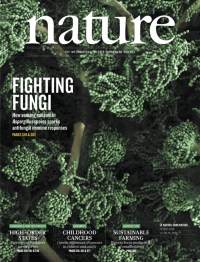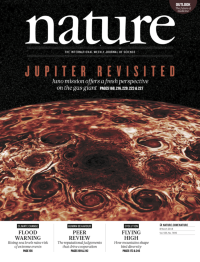Volume 555
-
No. 7698 29 March 2018
The dark caves that blind Mexican cavefish (Astyanax mexicanus) call home is an extreme environment in which food is scarce. As a result, the fish lead a famine-and-feast way life that has led them to adapt in a remarkable way, as Nicolas Rohner, Cliff Tabin and their colleagues reveal in this week's issue. The cavefish carry a mutation in the insulin receptor that would cause severe type 2 diabetes in humans. The resulting high blood-glucose levels seem to cause no ill effects in the fish, which are healthy and have a normal lifespan. The authors speculate that the fish have evolved compensatory mechanisms in their regulation of glucose that allow them to survive in their challenging environment. Cover image: Paulo Oliveira/Alamy
-
No. 7697 22 March 2018
The ubiquity of the optical laser means that it is easy to overlook its elder sibling, the maser. Essentially a 'microwave laser', the maser was developed in 1954 some six years before its optical counterpart. But the demanding conditions usually required for masers to function — cryogenic refrigeration and high-vacuum systems — have somewhat restricted their possible applications. Although room-temperature masers have been developed using molecular crystals, these have relatively poor thermal and mechanical properties and can operate only in pulsed mode. In this issue, Jonathan Breeze and his colleagues overcome these problems with a room-temperature maser that can operate in continuous-wave mode. The system uses a diamond (pictured on the cover) that contains defects called nitrogen–vacancy centres. Masers are already exploited for deep-space communications and radio astronomy, but this room-temperature device could expand their applications to medicine, security and quantum technologies. Cover image: Thomas Angus & Jonathan Breeze/Imperial College London; Stuart Penn
-
No. 7696 15 March 2018
The cover features a false-colour scanning electron microscopy image of the fungus Aspergillus fumigatus showing the specialized branches that produce its spores. In this issue, Gordon Brown and his colleagues examine the way in which mammals are able to detect melanin in the cell wall of these fungal spores. They identify a new cell receptor called MelLec that senses DHN-melanin and triggers an immune response which plays a key role in protecting the host against Aspergillus infection. Cover image: Kevin Mackenzie and Mark Stappers
Collection
-
No. 7695 8 March 2018
This week's issue presents four papers from the Juno mission to Jupiter. Alberto Adriani and his colleagues report visible and infrared observations of Jupiter's polar regions, finding that distinct cyclones appear at both poles. The cover image, derived from Juno's JIRAM instrument, shows the central cyclone at the planet's north pole and the eight cyclones that encircle it. The colours represent radiant heat: the yellow (thinner) clouds are about −13 °C in brightness temperature, and the dark red (thickest) are around −83 °C. In a second paper, Luciano Iess and his colleagues used Doppler data to study Jupiter's gravitational field, revealing a north—south asymmetry arising from atmospheric flows. In the third paper, Yohai Kaspi and his colleagues analyse the uneven gravitational harmonics to show that atmospheric jet streams extend some 3,000 kilometres below cloud level, concluding that the mass of Jupiter's dynamical atmosphere is about 1% of Jupiter's total mass. And in the fourth paper, Tristan Guillot and his co-workers show that below the depth of 3,000 kilometres, Jupiter is rotating as a solid body. Cover image: NASA/SWRI/JPL/ASI/INAF/IAPS
-
No. 7694 1 March 2018
Programmes aimed at meeting the UN's Sustainable Development Goals need to be informed by data. In two papers in this week's issue, Simon Hay and his colleagues present high-resolution geospatial maps that offer a detailed view of two key components of human capital from 51 African nations: child growth failure and educational inequality. Using survey and census data from thousands of villages across the continent, the authors gathered information on adult educational attainment, and child age, height and weight. They then used Bayesian modelling to combine these data with factors such as local geography and climate in order to extrapolate to regions where information was lacking. The result is a series of maps that show changes in educational attainment and child growth failure between 2000 and 2015 at a resolution of 5 km × 5 km. Although nearly every nation showed certain regions of improvement, the authors conclude that there is not a single country on the continent on track to meet the sustainable development goal of ending all malnutrition by 2030, and that gender inequality in education persists in many regions. Cover image: Jasiek Krzysztofiak/Nature





